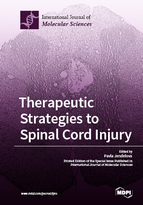Therapeutic Strategies to Spinal Cord Injury
A special issue of International Journal of Molecular Sciences (ISSN 1422-0067). This special issue belongs to the section "Molecular Pathology, Diagnostics, and Therapeutics".
Deadline for manuscript submissions: closed (20 April 2018) | Viewed by 93685
Special Issue Editor
Interests: spinal cord injury; neuroregeneration; axonal growth; cell therapy; inhibitory molecules; growth factors; astrogliosis; remyelination; neuroinflammation; biomaterials
Special Issue Information
Dear Colleagues,
Traumatic spinal cord injury (SCI) results in an immediate loss of motor and sensory function below the injury site and is associated with a poor prognosis. The inhibitory environment that develops in response to the injury is mainly due to local expression of inhibitory factors, scarring and the formation of cystic cavitations, all of which limit the regenerative capacity of endogenous cells. Current treatment modalities are focused on minimizing secondary injury and maximizing residual function via rehabilitation. Strategies that demonstrate promising results are performed in areas such as cellular therapy, growth factors (BDNF), inhibitory molecules, fibroglial scar, gene therapies, etc. Other promising experimental treatments focus on neuroprotection with hypothermia and pharmacologic therapies, regeneration facilitation via biomaterial transplantation, and rewiring with electrical stimulation. Some strategies have provided encouraging results by themselves; others have been tested as a combination, showing an improved outcome after SCI. Experimental evidence suggests that it is possible to obtain better results with a combination of strategies, which justifies further research for therapeutic approaches. This Special Issue intends to provide the most relevant information about available up-to-date therapeutic strategies that are administered alone or in combination with others, and have offered the best results in neural regeneration after spinal cord injury.
Assoc. Prof. Pavla Jendelova
Guest Editor
Manuscript Submission Information
Manuscripts should be submitted online at www.mdpi.com by registering and logging in to this website. Once you are registered, click here to go to the submission form. Manuscripts can be submitted until the deadline. All submissions that pass pre-check are peer-reviewed. Accepted papers will be published continuously in the journal (as soon as accepted) and will be listed together on the special issue website. Research articles, review articles as well as short communications are invited. For planned papers, a title and short abstract (about 100 words) can be sent to the Editorial Office for announcement on this website.
Submitted manuscripts should not have been published previously, nor be under consideration for publication elsewhere (except conference proceedings papers). All manuscripts are thoroughly refereed through a single-blind peer-review process. A guide for authors and other relevant information for submission of manuscripts is available on the Instructions for Authors page. International Journal of Molecular Sciences is an international peer-reviewed open access semimonthly journal published by MDPI.
Please visit the Instructions for Authors page before submitting a manuscript. There is an Article Processing Charge (APC) for publication in this open access journal. For details about the APC please see here. Submitted papers should be well formatted and use good English. Authors may use MDPI's English editing service prior to publication or during author revisions.
Keywords
- spinal cord injury
- neuroregeneration
- axonal growth
- plasticity
- cell therapy
- inhibitory molecules
- growth factors
- astrogliosis
- remyelination
- neuroinflammation







